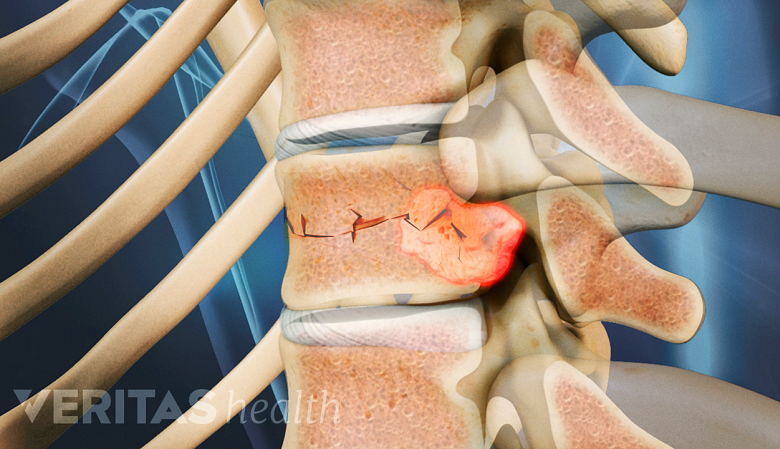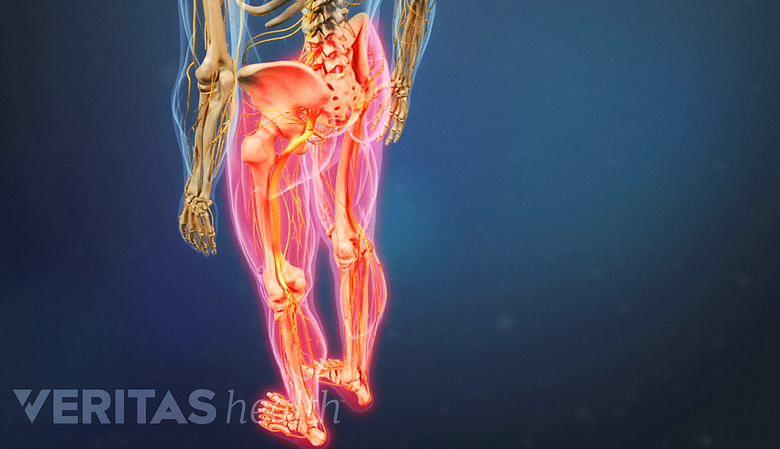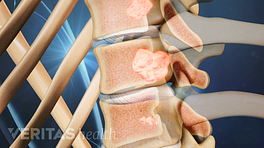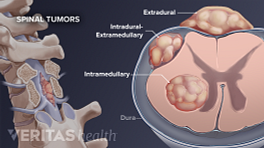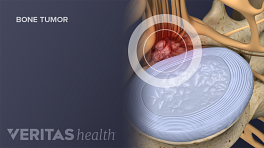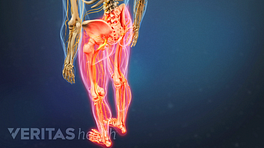The symptoms and signs of metastatic spinal tumors typically include back or neck pain, depending on the location within the spine. Neurological deficits, such as weakness, tingling or numbness in the arms or legs may also develop. These neurological deficits tend to occur several weeks or months following the onset of back pain. 1 Bilsky MH, Lis E, Raizer J, Lee H, Boland P. The diagnosis and treatment of metastatic spinal tumor. Oncologist. 1999. 4(6):459-69.
It is important to document the signs and symptoms because they can be used to help diagnose metastatic spinal tumors.
In This Article:
Metastatic Spinal Tumor Pain
Metastatic tumor pain is a burning or shock-like sensation that travels into the extremities.
Back pain that is caused by spinal tumors generally tends to be described as severe and not relieved by rest. There are various types of pain that can be caused by metastatic spinal tumors.
Aching Pain in the Bones
Tumor growth can result in a number of biological responses, such as local inflammation or stretching of the anatomical structures around the vertebrae. These biological sources of pain are often described as a deep ache that tends to be worse at night, even to the point of disrupting sleep. The pain may also be worse upon waking in the morning and improve somewhat after getting up and moving around.
Pain That Shoots Down the Arm or Leg
This type of nerve pain, also called radicular pain, travels along the path of the nerve—such as from the thoracic (mid-back) spine into the chest or from the lumbar (lower back) spine down the leg. Radicular pain is typically described as burning or shock-like pain that travels into the extremities.
Pain with Movement
A tumor growing within the vertebra weakens the bone walls, leading to fractures.
If the tumor is growing within the vertebra, the walls of the vertebral bone can become thin and weaken. If left untreated, the bones can fracture. A vertebral fracture can result in sudden onset of pain that tends to be more severe during movement or when placing pressure on the bone, such as when sitting or standing.
See Vertebral Fracture Symptoms
While pain is typically the first symptom of a metastatic spinal tumor, as time goes on it may be accompanied by neurological deficits.
Neurological Dysfunction
Spinal cord compression from a tumor causes numbness and weakness in the arm or leg.
Neurological deficits can occur if the metastatic spinal tumor growth or related vertebral fracture compresses neurological structures in or around the spine. Potentially serious neurological deficits may include:
Radiculopathy
When a spinal nerve root gets compressed, radiculopathy can occur with tingling, numbness, and/or weakness radiating into the chest, abdomen, leg, or arm. For example, a metastatic spinal tumor in the lumbar spine may compress a nerve root and cause pain and weakness in the leg. Radiculopathy is typically one-sided, but it can be bilateral if nerve roots are compressed on both sides of the spine.
See Radiculopathy, Radiculitis and Radicular Pain
Myelopathy
When the spinal cord gets compressed, myelopathy can occur. Neurological deficits may develop anywhere below the level of spinal cord compression. For example, spinal cord compression within the neck could cause tingling, numbness, and/or weakness to go into the arms or legs. Problems may also be experienced with coordination, reflexes, walking, and/or bowel/bladder dysfunction.
Cauda Equina Syndrome
Significant compression of the cauda equina (bundle of nerves descending into the lumbar spine from the spinal cord above) may result in varying degrees of bowel or bladder problems, lower extremity weakness and/or loss of sensation in the groin and/or inner thighs. This condition requires immediate medical attention and may require prompt surgery.
Watch Cauda Equina Syndrome Video
A correct and complete diagnosis of the metastatic spinal tumor is necessary to determine appropriate treatment.
- 1 Bilsky MH, Lis E, Raizer J, Lee H, Boland P. The diagnosis and treatment of metastatic spinal tumor. Oncologist. 1999. 4(6):459-69.
